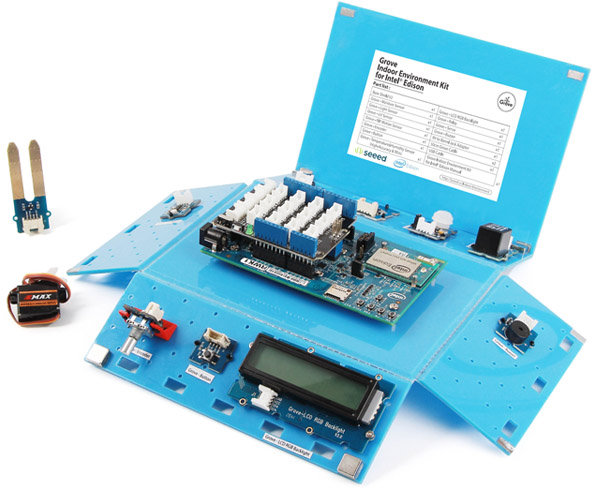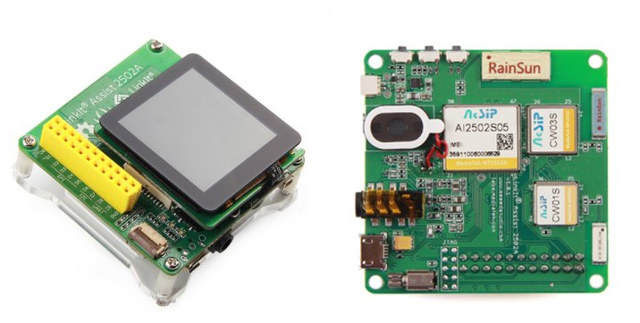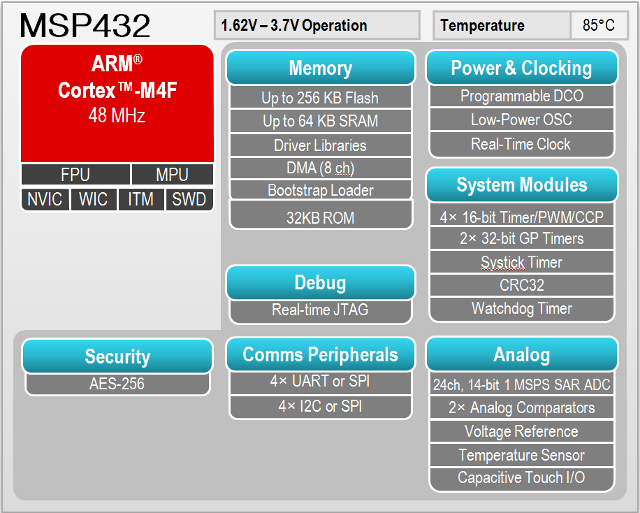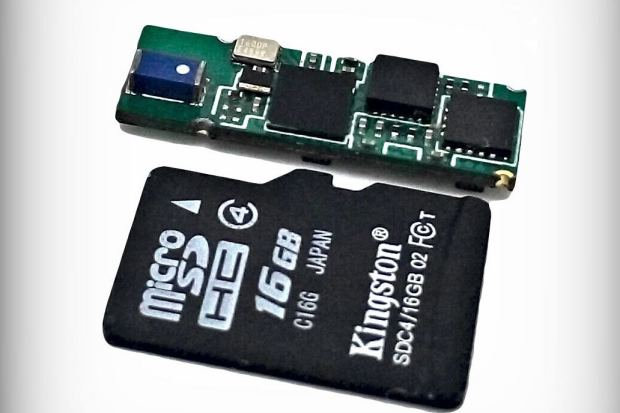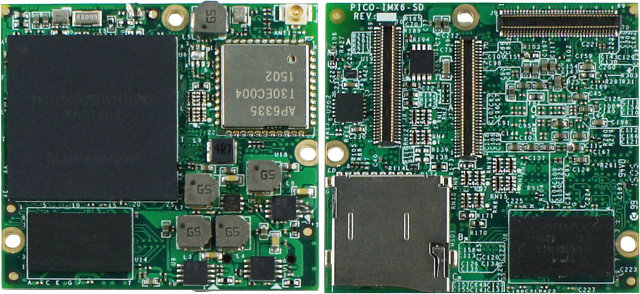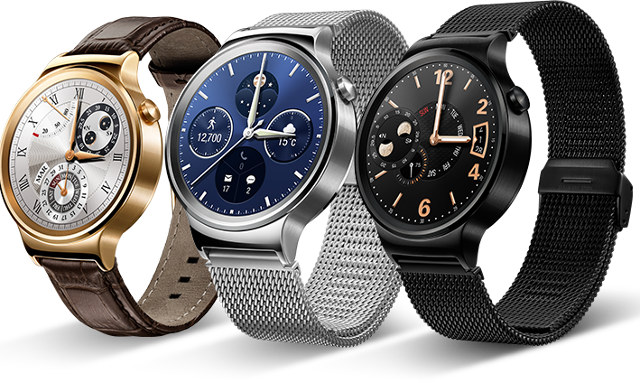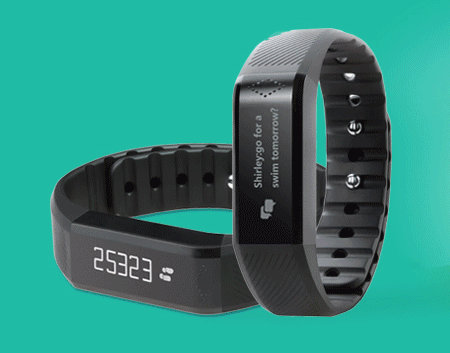Intel Edison is a $50 module with a dual core Atom processor @ 500Mhz and a single core Quark MCU @ 100 Mhz, Wi-Fi and Bluetooth 4.0, as well as headers for I/Os that’s destined to be used in wearables and IoT applications. Seeed Studio has now launched two kits for the Intel module for home automation and wearables. Grove Indoor Environment Kit for Intel Edison The automation kit comes in a small blue box with the following parts (Intel Edison and baseboard not included): 1x base shield v2 that plugs into Edison baseboard and allows Grove modules connections 11 grove modules – temperature & humidity, LCD RGB backlight, relay, moisture sensor, servo, light sensor, buzzer, UV sensor, PIR motion sensor, encoder and button. 2x 26 AWG Grove Cables 9V to barrel jack adapter 1x USB cables 1x User guide Programming is done with Edison Arduino IDE as explained in […]
Mifree HX-V5 Bluetooth Smart Fitness Tracker sells for $14
Mifree HX-V5 is a waterproof Bluetooth 4.0 activity tracker with fitness tracking and sleep monitoring functions just like Vidonn X5, except the device bring the price level to a new low, as it sells for just $14 including shipping on GeekBuying, and currently about $20 on Aliexpress, but there are few sellers, and more may come up around the $15 mark. HX-V5 smart band specifications differ depending on the sites too, not for the user exposed features, but for the internals [Update: GeekBuying told me they were given the wrong information, so I updated the specs accordingly): SoC – TI CC2541 Bluetooth SoC Storage – 4MB flash, enough to preserve 60 days of data Display – 0.91″ OLED display, 128×32 pixels Connectivity – Bluetooth 4.0 LE Sensors – 3-axis MEMS sensor IP Rating – IP67 (unlikely IMHO) Battery – 3.7V/70mAh Li-ion battery, good for 10 to 12 days. 2 to 3 hours charging time. Dimensions […]
Mediatek LinkIt Assist 2502 Open Source Hardware Board Targets Wearables and IoT Applications
After LinkIt ONE, Mediatek Labs has introduced a new IoT development kit based on their Aster M2502 ARM7 processor with LinkIt Assist 2502 comprised of AcSiP MT2502A IoT SiP Core module, a 802.11b/g/n module, a GNSS module, and an exchangeable 240×240 16-bit color capacitive touch LCM Board. The AcSiP module can also be purchased separately, so you could use LinkIt Assist 2502 board for early development, because moving to your custom hardware based on AcSiP MT2502A module. LinkIt Assist 2502A specifications: MCU – AcSiP AI2502S05 module with MT2502A (Aster) ARM7 EJ-STM processor @ 260MHz, 4MB RAM, 16MB flash Display – 240×240 LCD module; 16-bit color depth; transflective; based on ST7789S driver IC. Connectivity Wi-Fi 802.11 b/g/n via AcSiP CW01S module based on MT5931 SoC Bluetooth 2.1 SPP and 4.0 GATT dual mode (part of MT2502A) GPS via AcSiP CW03S module based on MT3332 chip supporting GPS, GLONASS, and BeiDou. GSM […]
Texas Instruments Introduces MSP432 ARM Cortex-M4F MCU Family
Texas Instruments has just launched a successor for its 16-bit MSP430 MCU family with MSP432 MCU series featuring a 32-bit ARM Cortex-M4F core, a DSP, up to 256 KB flash, up to 64 KB SRAM, and according to the company ” delivering a ULPBench score of 167.4 outperforming all other Cortex-M3 and -M4F MCUs on the market”. The new MCU family targets consumer & portable electronics, building & factory automation & control, smart grid & energy, healthcare & fitness, and wearables applications. Key features listed for MSP432P4xx: MCU – 32-bit ARM Cortex-M4F up to 48 MHz with FPU and DSP. Delivers 3.4 Coremark/MHz Memory – Up to 64 KB RAM; Selectable RAM retention Storage – Up to 256 KB Flash; dual bank for simultaneous reading and writing Security – 256-bit AES encryption, JTAG access lock, 4 IP Protection regions EnergyTrace Technology Real-time power measurement and debugging Generate application energy profiles including […]
XBAND is a Tiny $10 Bluetooth Low Energy Sensor Module (Crowdfunding)
ZX Tek‘s XBAND is a board about half the size of a micro SD that comes with a Bluetooth LE radio and a 6-axis MPU6500 motion sensor that can be integrated into wearables and IoT applications such as a remote controlled robot with a camera., a wireless smart light-bulb, and iBeacon device and so on. There seems to be two versions of the module XBAND 061-N51822 and XBAND 1018-CY8C4247 with the following specifications: SoC (one or the other) Nordic Semiconductor nRF51822 ARM Cortex M0 MCU @ 16 MHz with 256KB Flash, 16KB RAM, and Bluetooth Low Energy support Cypress PSoC4 BLE core ARM Cortex M0 MCU @ 48 MHz with 128KB flash, 16KB RAM, and Bleutooth Low Energy support Bluetooth – 4.0/4.1 with high gain ceramic chip antenna Sensors – On-board 6-axis MPU6500 motion sensor + an extra configurable sensor (not idea what that is…). Connectors – Board-to-board connectors with […]
TechNexion Introduces Intel Edison Compatible PICO-iMX6 SoM and DWARF Board
Intel Edison is a board made for wearables featuring an SoC with Intel Atom and Quark CPU cores. TechNexion, an embedded systems company based in Taiwan, has decided to make a mechanically and electrically compatible system-on-module featuring Frescale i.MX6 Solo or Duallite ARM Cortex A9 processor called PICO-iMX6. The company is also providing a PICO-DWARF baseboard that’s both compatible with PICO-iMX6 SoM and Edison board. DWARF stands for “Drones, Wearables, Appliances, Robotics and Fun”, so that pretty much explains what the platform is for. PICO-iMX6 System-on-Module Two version of the modules are available: PICO-iMX6-SD and PICO-iMX6-EMMC, the former with a micro SD slot for storage, and the latter a 4GB eMMC. Both share the followings specifications: SoC – Freescale i.MX6 Solo / Duallite single/dual core ARM Cortex A9 @ 1Ghz with Vivante GC880 3D GPU and Vivante GC320 2D GPU (Composition) System Memory – 512MB or 1GB DDR3 Storage – […]
Huawei Watch May Be the Best Looking Android Wear Smartwatch So Far
If you think Motorola Moto 360 looks good, but find the black zone at the bottom of the display ruins it all, Huawei Watch may be what you’ve been looking for, with a similar rounded shape design, Android Wear, and when it is in watch mode it really looks like a standard watch without obstructions. Let’s go through the specifications first: SoC – Qualcomm Snapdragon 400 (APQ8026) quad core Cortex A7 @ 1.2GHz with Adreno 305 GPU System Memory – 512MB RAM Storage – 4GB ROM Display – 1.4″ full circle AMOLED display; 400×400, 286ppi; Sapphire crystal Audio – Built-in MIC Connectivity – Bluetooth 4.0/4.1 Sensors – Gyroscope + Accelerometer, PPG (photoplethysmogram – for heart rate), Barometer, Vibration Motor Misc – Watch button at 2 o’clock Battery – 300mAh Material – Watch: 316L Stainless Steel; Watchband: stainless steel or leather Dimension – 42mm diameter by 11.3mm thickness Weight – […]
Vidonn X6 Activity Tracker Promises Up to 15 days Battery Life
I reviewed Vidonn X5 fitness tracker last yet, and I found many issues or letdowns: battery life is too short (2 days), the digits are much smaller than advertized, the screen cannot be read under direct sunlight, a button must be pressed to check the time, the smartband is not as waterproof as advertized, and the Android app is a disaster. Despite all these issues, I still wear it everyday, as it helps me walk or run a bit more if I have not reached my daily target. The company has now release a new model Vidoon X6 that I discovered today on DealExtreme for $33.90. Vidonn X6 specifications: MCU/Memory – Unknown Display – 0.88″ OLED display (vs 0.49″ for X5) Connectivity – Bluetooth 4.0 LE and micro USB Battery – 45 mAh Li-battery (vs 40 mAh) good for 15 days in standby mode. IP Rating – IP65 (Dust-proof and […]


